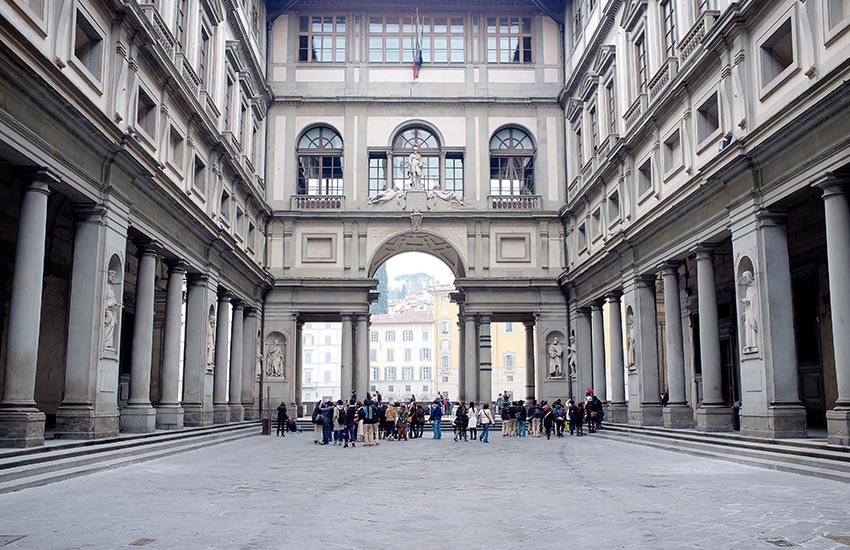Todo lo que necesita saber sobre la Academia y los Uffizi en Florencia
10 julio, 2018 (13:46:42)The Accademia and Uffizi galleries are the two most visited museums in Florence. Each year, millions of visitors pass through its rooms adorned with art. Both are home to numerous and invaluable masterpieces of the Renaissance period. But how did such extensive collections come about? Let's take a look at his past to discover it.
Academy Gallery
origins
The Galleria dell'Accademia was founded in the 18th century by Grand Duke Peter Leopold of Lorraine. Originally, it was intended to serve as a teaching facility for the students of the nearby Academy of Fine Arts. Over the years, the collection of the gallery became more diverse thanks to the efforts of the Grand Duke and later, even to Napoleon himself. Compared to other museums, the Gallery of the Academy is quite small. However, it has an impressive artistic heritage.
David by Michelangelo
The most famous work of art in Accademia is the statue of David by Michelangelo. He worked in sculpture from 1501 to 1504 and sculpted it in a single block of marble. Not many people know that, originally, they intended to place David on top of the facade of Brunelleschi's Duomo. However, once Michelangelo finished, they realized that hiding David at such a high level would be a waste. A commission of prominent artists and citizens decided to place the statue in front of Palazzo Vecchio, in Piazza della Signoria. However, in 1872, the city decided to move David to the Accademia for its preservation; It took three days to move the statue!

Other notable works
While David is undoubtedly impressive, the gallery offers many more delights. For example, the Hall of Prisoners took its name from the four large naked male sculptures known as the "Prisoners" or "Slaves." Originally, they were created by Michelangelo to adorn the tomb of Pope Julius II. These sculptures are particularly famous for their unfinished state. Michelangelo left them so intentionally, to represent the eternal struggle of humans to free themselves from the limits and physical weight of matter. Other great works include a copy of Rape of the Sabines by Giambologna; Tree of Life of Pacino di Buonaguida; paintings by Giotto, Botticelli, Bartolini and more.
Department of Musical Instruments
In the 20th century, Accademia opened a new collection, a Department of Musical Instruments. The more than 50 instruments exhibited include pieces from the famous Cherubini Conservatory that connects directly to the gallery. Most of them were originally part of the private collections of the Grand Dukes of Tuscany and the Medici family).
Uffizi Gallery
origins
Unlike Accademia, the Uffizi Gallery is incredibly large and its art collection is even more so. Few people know that the building that houses the gallery today was not built to be a museum. In 1560, Cosimo I de 'Medici, the Grand Duke of Tuscany, commissioned the construction to house the judiciary and the administrative offices. In fact, the word "uffizi" in old Italian is translated as "offices".

The collections
La colección de pinturas, camafeos, joyas, estatuas, miniaturas, bronces, instrumentos científicos de Francesco del siglo XV creció con cada nueva generación de Medici. El Salón de los Mapas Geográficos, que muestra mapas de los dominios Medici en Florencia, Siena y Elba, y la Sala de Matemáticas se agregaron entre los siglos XVI y XVII. En 1588, la galería abrió el Opificio Delle Pietre Dure, un famoso taller de mosaicos de piedras semipreciosas que aún existe en la actualidad. También puedes ver muchas obras de arte con nombres como Tiziano, Rafael, Piero Della Francesca, Federico Barocci y otros. Tanto la Academia como los Uffizi deberían estar en la cima de la lista de atracciones de Florencia de todos los viajeros. No solo muestran las obras maestras artísticas, sino que también pintan una imagen del rico pasado de la creatividad de la ciudad. Debido a su popularidad, se recomienda comprar sus boletos con anticipación para evitar las largas colas.